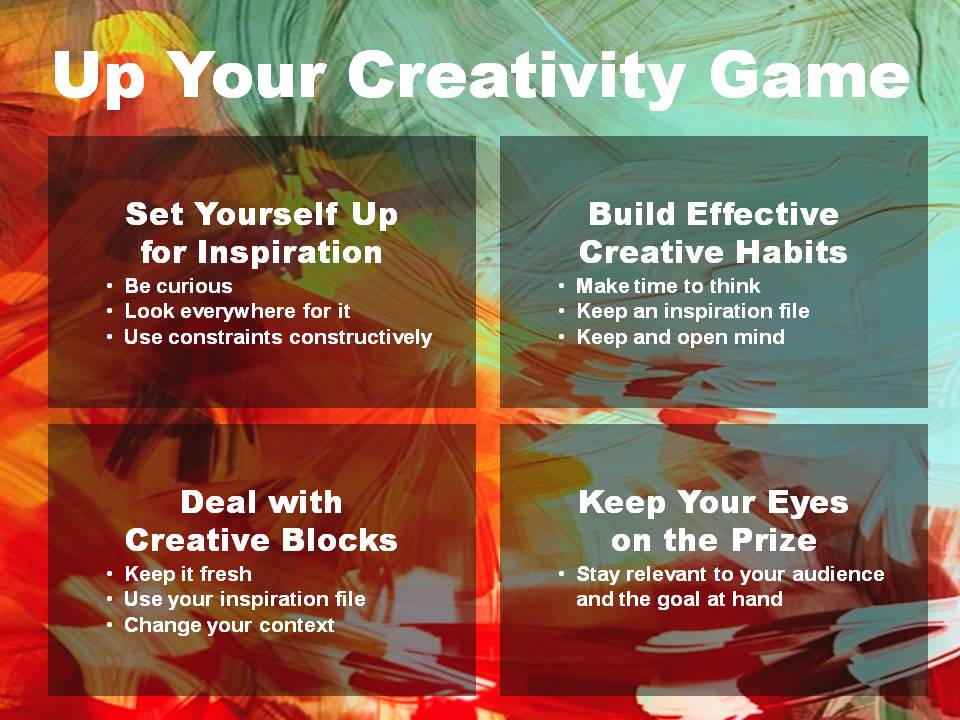No matter where you work within the marketing function, you need to be creative. But don’t make the mistake of confusing creativity with being artistic. Creativity isn’t just about design and campaign concepts; it’s a mindset that enables you to generate ideas for solving problems and creating outputs, whatever those may be for you.
Everyone has the potential to be creative in some way. Everyone.
It’s true that some people are naturally more creative than others, but that doesn’t mean creativity can’t be cultivated. With practice, you can build those muscles and up your own creativity game.
Set Yourself Up for Inspiration
Be curious
 There is a documented correlation between curiosity and creativity. In fact, a 2017 study found that general curiosity led to more information seeking which, in turn, directly led to higher creativity. The instinct to explore keeps our minds open—a must for creative inspiration. What can you do to foster your curiosity? Read. Ask lots of questions. Do stuff you don’t know how to do.
There is a documented correlation between curiosity and creativity. In fact, a 2017 study found that general curiosity led to more information seeking which, in turn, directly led to higher creativity. The instinct to explore keeps our minds open—a must for creative inspiration. What can you do to foster your curiosity? Read. Ask lots of questions. Do stuff you don’t know how to do.
Look everywhere for it
There’s no “creativity tap” from which originality flows in a steady and controllable stream. Inspiration doesn’t usually strike where and where we need it to. Sometimes you have to go looking for it. Don’t stay close to home in your quest. Inspiration can come from anywhere. The farther afield, the more truly innovative it can be. The trick is to see it and make it relevant for you.
Use constraints constructively
Everyone operates under constraints—budgets, deadlines, requirements, dependencies, technology, legal, etc.—that restrict you in some way. Don’t think of these as limitations; rather treat them as opportunities for inspiring creativity. Often, the most creative solutions are born of a need to overcome a specific set of limitations.
Build Effective Creative Habits
Make time to think
To develop creative solutions—be they campaigns, programs, content, or responses to pressing challenges—you need time to think. But don’t spend all that time trying to come up with answers. Einstein is reported to have said, “If I had an hour to solve a problem, I’d spend 55 minutes thinking about the problem and 5 minutes thinking about solutions.” Careful deliberation about what you’re trying to accomplish enables you to ask better questions, which can lead you to better answers.
Keep an inspiration file
 Great ideas can strike at any time (what is it about the shower?). If you don’t record them in the moment, they can disappear forever. Keep a notebook handy, or use an app, to capture them for future use. See a good idea? Jot it down. Brainstorm more good concepts than you can use right now? Maybe you can use them later.
Great ideas can strike at any time (what is it about the shower?). If you don’t record them in the moment, they can disappear forever. Keep a notebook handy, or use an app, to capture them for future use. See a good idea? Jot it down. Brainstorm more good concepts than you can use right now? Maybe you can use them later.
Keep an open mind
Noted creative thinking expert Edward de Bono said, “It is better to have enough ideas for some of them to be wrong, than to be always right by having no ideas at all.” Focus on generating lots of ideas, not just on generating good ideas. Treat them like clothing – you have to try them on to see if they fit. By having lots of creative ideas and considering each one, you’ll find that even bad ideas can spark great ones.
Deal with Creative Blocks
Keep it fresh
Don’t let yourself get into a rut. While you do want to keep what works, it’s worth always looking for a creative twist on an existing campaign, program, process, what have you. Look for new ways to improve results. Set yourself up for ongoing success by setting yourself up for ongoing discovery.
Use your inspiration file
It can be an invaluable resource when you are in a creative rut.
Change your context
Sometimes the creative well runs dry. It happens to the best of us and it can be extremely frustrating. If you’re really struggling, don’t try harder—stop trying for awhile. Do something else. Take a 10-minute walk. Or just move to a different part of the office. Relieving yourself of the pressure and changing your perspective can help get the creative juices flowing again.
Keep Your Eyes on the Prize
It’s important to remember that just because something is creative or clever, that doesn’t mean it’s effective. It has to be relevant to your audience and the goal at hand. But creativity that drives meaningful results—that’s pure magic.


